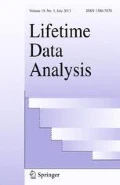Abstract
We consider a Bayesian analysis method of paired survival data using a bivariate exponential model proposed by Moran (1967, Biometrika 54:385–394). Important features of Moran’s model include that the marginal distributions are exponential and the range of the correlation coefficient is between 0 and 1. These contrast with the popular exponential model with gamma frailty. Despite these nice properties, statistical analysis with Moran’s model has been hampered by lack of a closed form likelihood function. In this paper, we introduce a latent variable to circumvent the difficulty in the Bayesian computation. We also consider a model checking procedure using the predictive Bayesian P-value.




Similar content being viewed by others
References
Batchelor JR, Hackett M (1970) HL-A matching in treatment of burned patients with Skin Allografts. Lancet 2:581–583
Bayarri BA, Berger JO (2000) p values for composite null models. J Am Stat Assoc 95:1127–1142
Chen M-H, Shao Q-M, Ibrahim JG (2000) Monte Carlo methods in Bayesian computation. Springer-Verlag, New York
Clayton D (1978) A model for association in bivariate life tables and its applications in epidemiological studies of familial tendency in chronic disease incidence. Biometrika 65:141–151
Gilks WR, Wild P (1992) Adaptive rejection sampling for Gibbs sampling. Appl Stat 41(2):337–348
Gumbel EJ (1960) Bivariate exponential distributions. J Am Stat Assoc 55:698–707
Holt JD, Prentice RL (1974) Survival analysis in twin studies and matched pair experiments. Biometrika 61:17–30
Hougaard P (1995) Frailty models for survival data. Lifetime Data Anal 1:255–273
Huster WJ, Brookmeyer R, Self SG (1989) Modelling paired survival data with covariates. Biometrics 45:145–156
Jung SH (1999) Rank tests for matched survival data. Lifetime Data Anal 5:67–79
Jung SH, Su JQ (1995) Non-parametric estimation for the difference or ratio of median failure times for paired observations. Stat Med 14:275–281
Lee EW, Wei LJ, Amato DA (1992) Cox-type regression analysis for large numbers of small groups of correlated failure time observations. In: Klein JP, Goel PK (eds) Survival analysis: state of the art. Dordrecht, Kluwer Academic, pp 237–247
Lee EW, Wei LJ, Ying Z (1993) Linear regression analysis for highly stratified failure time data. J Am Stat Assoc 88:557–565
Lin DY, Ying Z (1993) A simple nonparametric estimator of the bivariate survival function under univariate censoring. Biometrika 80:573–581
Lin JS, Wei LJ (1992) Linear regression analysis for multivariate failure time observations. J Am Stat Assoc 87:1091–1097
Marshall AW, Olkin I (1967) A multivariate exponential distribution. J Am Stat Assoc 62:30–44
Meng XL (1994) Posterior predictive p-values. Ann Stat 22:1142–1160
Moran PAP (1967) Testing for correlation between non-negative variates. Biometrika 54:385–394
Shih JH, Louis TA (1995) Assessing gamma frailty models for clustered failure time data. Lifetime Data Anal 1:205–220
Woolson RF, Lachenbruch PA (1980) Rank tests for censored matched pairs. Biometrika 67:597–606
Acknowledgements
Jaeyong Lee was supported by Korea Research Foundation Grant (KRF-2003-041-C00054).
Author information
Authors and Affiliations
Corresponding author
Appendix
Appendix
Derivation of (3)
Note \((Z_1,Z_3)\) and \((Z_2,Z_4)\) are IID bivariate normal random vectors with means 0 and covariance matrix (1). From the density of \((Z_1,Z_3)\) and \((Z_2,Z_4)\), change of variable technique using (1) yields the density of \((X_1,X_2,\eta_1,\eta_2)\),
where \(x_1, x_2 \geq 0, 0 \leq \eta_1, \eta_2 \leq 2\pi\). Let \(V_1 = \eta_1 -\eta_2\) and \(V_2 = \eta_1.\) Then, the density of \((X_1,X_2,V_1,V_2)\) is
where \(-2\pi \leq v_1 \leq 2\pi,\) and \(0 \leq v_2 \leq 2\pi+v_1\) for \(-2\pi \leq v_1 < 0\) and \(v_1 \leq v_2 \leq 2\pi\) for \(0 \leq v_1 \leq 2\pi.\) Integrating out v 2, we get the density of \((X_1,X_2,V_1)\)
Note the density of \((X_1,X_2,V_1)\) is symmetric in v 1 about 0. Letting \(U = |V_1|\), we get the density of \((X_1,X_2,U)\), (3).
Proof of Proposition 1
It suffices to show that the posterior is proper when the data set consists of two pairs of uncensored survival times \(D = \{(x_{11},x_{21},\delta_{11},\delta_{21}), (x_{12},x_{22},\delta_{12},\delta_{22})\}\) with \(\delta_{ji} = 1\) for i,j = 1,2. The posterior with prior (7) is proportional to
where \(0 < \rho < 1\), \(\lambda_1, \lambda_2 > 0\) and \(0 < u_1, u_2 < 2\pi\) and \(a(x) \preceq b(x)\) means b(x) is bigger than or equal to a constant multiple of a(x). Integrating out u 1 and u 2, we get
where \(Q_0(\lambda_1,\lambda_2) = \sum_{i=1}^2 \left(\sqrt{\lambda_1x_{1i}} - \sqrt{\lambda_2 x_{2i}} \right)^2\). With the transformation \(t = 1/(1-\rho)\),
With \(\mu_j =\sqrt{\lambda_j}\), for j = 1,2,
where
and
With the assumption of Proposition 1, the matrix A(D) is a positive definite matrix. Hence, the RHS of (8) defines an integration with respect to a nonsingular bivariate normal density. Since every polynomial order moment exists for a nonsingular bivariate normal distribution, we conclude (8) is finite. \(\square\)
Rights and permissions
About this article
Cite this article
Lee, J., Kim, J. & Jung, SH. Bayesian analysis of paired survival data using a bivariate exponential distribution. Lifetime Data Anal 13, 119–137 (2007). https://doi.org/10.1007/s10985-006-9022-0
Received:
Accepted:
Published:
Issue Date:
DOI: https://doi.org/10.1007/s10985-006-9022-0




